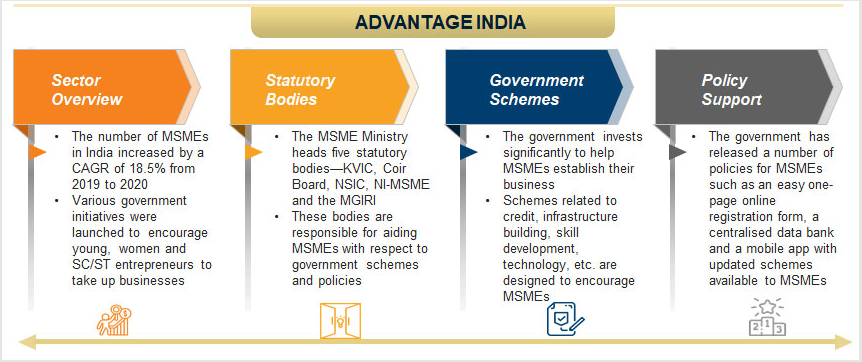Changes to MSME Definition
To provide a boost in the MSME sector, the government has recently made some changes in MSMEs under MSMED Act, 2006 which has been activated from July 1, 2020.

New MSME Definition
The new classification of what is MSME will fall into two categories, first, the annual turnover and the second is an investment in plant/machinery/ and manufacturing.
| MSME: Investment and Annual Turnover |
| Sector/Enterprise Type | Micro Enterprise | Small Enterprise | Medium Enterprise |
| Both (Manufacturing & Services Sector) | Investment < Rs. 1 crore & Turnover < Rs. 5 crore | Investment < Rs. 10 crore & Turnover up to Rs. 50 crore | Investment < Rs. 50 crore & Turnover up to Rs. 250 crore |
The advantage of the new MSME definition is:
- MSME Loans worth Rs. 3 lakh crore
- The moratorium period is extended to 12 months
- Both Manufacturing and Service MSMEs will treat the same
- Repayment Tenure of 48 months
- 100% Credit Guarantee
- To benefit approx. 45 lakh units
Companies can avail of an MSME loan from Ziploan to expand their business and sales. The MSME loan eligibility criteria of Ziploan are easy to meet as we don't ask for bundles of documents.
Whether you want to do infrastructure improvement, upgrade machinery, manage working capital, or purchase raw materials, etc. MSME loan is a great choice you can opt for.
Old MSME Definition
As per the old MSME definition, Micro, Small and Medium Enterprise were classified on the basis of investment into two divisions as below:
| Manufacturing Sector | Service Sector |
| Enterprise Category | Investment in plant and machinery | Micro Enterprises | Investment should not exceed Rs. 10 lakh |
| Micro Enterprises | Should not exceed Rs. 25 lakh | Small Enterprises | More than Rs. 10 lakh, should not exceed Rs. 2 crore |
| Medium Enterprises | More than Rs. 5 crores, shall not exceed Rs. 10 crore | Medium Enterprises | More than Rs. 2 crore, shall not exceed Rs. 5 crore |
Features of MSMEs
Following are some of the crucial elements of MSMEs:
- MSMEs work for the welfare of the workers and artisans. They provide collateral-free loans to set up and run their business.
- Provides credit limit or funding support from banks.
- Help in skill up gradation via specialized training centers.
- Supports technology up-gradation, infrastructural development, and modernization.
- Offers assistance for improved access to domestic and export markets.
- Provides the latest testing facilities and quality certification.
- Supports packaging, product development, and design intervention.
Some of the entities that work under the Ministry of MSME are as follows:
- A Scheme for Promotion of Innovation, Rural Industries and Entrepreneurship (ASPIRE)
- Khadi and Village Industries Commission (KVIC)
- Mahatma Gandhi Institute for Rural Industrialization (MGIRI)
- National Institute for Micro, Small and Medium Enterprises (NIMSME)
- National Small Industries Corporation (NSIC)
- Scheme of Fund for Regeneration of Traditional Industries (SFURTI)
Some of the government schemes that promote MSME to people:
- Prime Minister Employment Generation Program (PMEGP)
- Micro & Small Enterprises Cluster Development (MSE-CDP)
- EDP/MDP schemes
- Entrepreneurial and Managerial Development of SMEs through Incubators
- MSME Market Development Assistance (MDA)
- Marketing Assistance & Technology Upgradation (MATU)
- Revamped Scheme of Fund for Regeneration of Traditional Industries (SFURTI)
- Credit Guarantee Trust Fund for Micro & Small Enterprises (CGTMSE)
- Credit Linked Capital Subsidy for Technology Upgradation
- Financial Support to MSMEs in ZED Certification Scheme
- Technology and Quality Upgradation Support to MSMEs
- Lean Manufacturing Competitiveness for MSMEs
- Design Clinic for Design Expertise to MSMEs
- Assistance to Training Institutions (ATI)
- A Scheme for Promoting Innovation, Rural Industry & Entrepreneurship (ASPIRE)
- Skill Upgradation & Mahila Coir Yojana (MCY)
- Market Promotion & Development Scheme (MPDA)
- Performance and Credit Rating Scheme
- Marketing Support/Assistance to MSMEs (Bar Code)
Role of MSMEs in Indian Economy
India has around 6.3 crores registered MSMEs. The number of registered MSMEs grew 18.5% Y-o-Y to reach 25.13 lakh units in 2020 from 21.21 lakh units in 2019. New online system of MSME/Udyam Registration launched by the Union MSME Ministry, w.e.f. July 01, 2020, successfully registered more than 1.1 million MSMEs until November 2020.
MSMEs have created more employment in rural areas where employment was a big challenge because of the lack of big industries and companies. MSMEs also play an important role when in need of low investment, flexibility in operations, cost-effective imports, and huge demand for production.
Moreover, MSMEs help entrepreneurs to learn new skills, adopt new technologies, and eventually help them set up a successful business and help in the nation's economy.
Contribution of MSMEs in Country’s Economy at Current Price
| Year | MSME Gross Value Added | Growth (%) | Total Grass Value Added | Share of MSME in GVA (%) | Total GDP | Share of MSME in GDP (in %) |
| 2011-12 | 2622574 | - | 8106946 | 32.35 | 8736329 | 30 |
| 2012-13 | 3020528 | 15.17 | 9202692 | 32.82 | 9944013 | 30.40 |
| 2013-14 | 3389922 | 12.23 | 10363153 | 32.71 | 11233522 | 30.20 |
| 2014-15 | 3704956 | 9.29 | 11504279 | 32.71 | 12467959 | 29.70 |
| 2015-16 | 4025595 | 8.65 | 12566646 | 32.03 | 13764037 | 29.20 |
| 2016-17 | 4405753 | 9.44 | 13841591 | 31.38 | 15253714 | 28.90 |
Source: Central Statistics Office (CSO), Ministry of Statistics & Program ImplementationImportance of MSME
MSME has become the backbone of the Indian economy since 2006. It is responsible for large-scale employment in rural areas by providing them an easy business loan and essential training. It contributes around 29% towards the GDP through its national and international trade.



